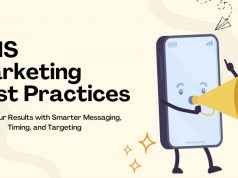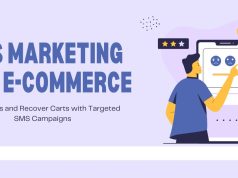Short Message Service (SMS) marketing has evolved from simple text alerts to a powerful channel that delivers impressive results. With open rates exceeding 98% and response rates that dwarf email marketing, SMS offers businesses a direct line to their customers’ attention.
But crafting effective SMS marketing messages requires more than just typing out a quick text. The 160-character limit, compliance requirements, and the personal nature of mobile devices create unique challenges that demand strategic thinking and careful execution.
This guide will walk you through everything you need to know about writing SMS messages that engage customers, drive action, and deliver measurable results for your business.
Understanding SMS Marketing Fundamentals
SMS marketing involves sending promotional messages directly to customers’ mobile phones. Unlike email, which can sit unread for hours or days, text messages typically get read within minutes of delivery.
The power of SMS lies in its immediacy and simplicity. There are no images to load, no formatting to render, and no spam folders to navigate. Your message appears directly on the recipient’s screen, making it impossible to ignore.
However, this direct access comes with responsibility. Mobile phones represent personal space, and customers expect SMS messages to provide genuine value. Poorly written or irrelevant messages can damage your brand reputation and lead to opt-outs.
Key Components of Effective SMS Marketing Messages

Compelling Subject Lines and Hooks
Your opening words determine whether recipients read further or delete your message immediately. Start with action words, questions, or compelling offers that grab attention within the first few words.
Strong opening phrases include “Last chance,” “Exclusive offer,” “Breaking news,” or “Quick reminder.” These phrases create urgency and indicate immediate value.
Clear Call-to-Action
Every SMS marketing message should include one clear, specific action you want recipients to take. Whether it’s visiting a website, making a purchase, or calling a number, make your desired outcome obvious.
Use action verbs like “Shop now,” “Call today,” “Visit us,” or “Download here.” Avoid vague instructions like “learn more” or “check it out” that don’t clearly indicate the next step.
Value Proposition
Recipients need to understand what they’ll gain by taking your suggested action. Whether it’s a discount, exclusive access, important information, or convenience, communicate the benefit clearly and quickly.
Contact Information and Branding
Include your business name so recipients immediately know who sent the message. This builds trust and reduces confusion, especially for customers who may not have your number saved in their contacts.
Writing Techniques for SMS Marketing Success

Mastering the Character Limit
Standard SMS messages have a 160-character limit, including spaces and punctuation. This constraint forces you to communicate efficiently and prioritize your most important information.
Use abbreviations strategically, but avoid text speak that might confuse recipients. Common abbreviations like “w/” for “with” or “&” for “and” can save precious characters without sacrificing clarity.
Consider breaking longer messages into multiple texts if necessary, but ensure each message can stand alone in case they arrive out of order.
Personalization Strategies
Personalized messages perform significantly better than generic broadcasts. Use recipient names, purchase history, location data, or behavioral information to make messages feel relevant and tailored.
Simple personalization like “Hi Sarah” or “Perfect for your yoga class” makes messages feel less like mass marketing and more like personal communication.
Timing and Frequency
Send messages when recipients are most likely to engage. Generally, this means avoiding early morning, late evening, or traditional work hours unless your audience specifically expects messages during these times.
Respect frequency preferences and avoid overwhelming recipients with too many messages. Most successful SMS campaigns send no more than 2-4 messages per month per subscriber.
Compliance and Legal Considerations

Obtaining Proper Consent
SMS marketing requires explicit opt-in consent from recipients. This means customers must actively choose to receive messages, not just fail to opt-out during a purchase or sign-up process.
Implement double opt-in processes where customers confirm their subscription via a follow-up message. This ensures genuine interest and protects your business from compliance issues.
Required Disclosures
Include clear opt-out instructions in every message, typically “Reply STOP to unsubscribe” or similar language. This requirement protects consumer rights and maintains compliance with regulations.
Add message and data rate warnings where appropriate, especially for promotional campaigns that might generate additional charges for recipients.
Industry-Specific Regulations
Different industries face varying SMS marketing regulations. Healthcare, finance, and telecommunications businesses often have stricter requirements than retail or hospitality companies.
Research regulations specific to your industry and location. Consider consulting with legal professionals if you’re unsure about compliance requirements.
Different Types of SMS Marketing Messages
Promotional Messages
These messages advertise sales, new products, or special offers. They should clearly communicate the offer, its value, and how to redeem it.
Example: “Flash Sale! 30% off all summer dresses today only. Show this text in-store or use code SUMMER30 online. Shop now: [link]”
Transactional Messages
Order confirmations, shipping notifications, and appointment reminders fall into this category. These messages provide expected information and typically see higher engagement rates.
Example: “Your order #1234 has shipped! Track your package: [link]. Questions? Reply or call 555-0123.”
Reminder Messages
Appointment confirmations, bill due dates, or subscription renewals help customers stay organized while reducing no-shows and missed payments.
Example: “Reminder: Your dentist appointment is tomorrow at 2 PM. Reply Y to confirm or C to reschedule. See you soon!”
Welcome Messages
These introduce new subscribers to your SMS program and set expectations for future communications.
Example: “Welcome to [Brand] SMS! Get exclusive offers, early access to sales, and order updates. First-time customer? Use code WELCOME10 for 10% off.”
Testing and Optimization Strategies
A/B Testing Elements
Test different message elements to optimize performance. Try variations in opening lines, calls-to-action, offers, or send times to identify what resonates best with your audience.
Focus on testing one element at a time to clearly identify what drives performance changes. Test with statistically significant sample sizes to ensure reliable results.
Measuring Success Metrics
Track delivery rates, open rates, click-through rates, and conversion rates to assess message effectiveness. Monitor opt-out rates to ensure your messages provide value without overwhelming recipients.
Set up proper tracking links and promo codes to measure the direct impact of SMS campaigns on sales and customer behavior.
Continuous Improvement
Use performance data to refine your approach over time. Identify patterns in high-performing messages and replicate successful elements in future campaigns.
Stay updated on SMS marketing trends and platform changes that might affect your strategy or compliance requirements.
Common SMS Marketing Mistakes to Avoid
Many businesses make critical errors that reduce SMS marketing effectiveness. Avoid sending messages without clear value propositions, overwhelming subscribers with too many messages, or failing to maintain compliance with regulations.
Don’t assume all customers want the same types of messages. Segment your audience based on preferences, purchase history, or engagement levels to deliver more relevant content.
Never purchase SMS lists or send messages to people who haven’t explicitly opted in. This practice violates regulations and damages your sender reputation.
Advanced SMS Marketing Techniques
Integration with Other Channels
Coordinate SMS campaigns with email marketing, social media, and other channels for consistent messaging and maximum impact. Use SMS to drive traffic to other platforms or reinforce messages delivered through different channels.
Automation and Workflows
Set up automated message sequences triggered by customer actions or dates. Welcome series, abandoned cart reminders, and birthday offers can run automatically while delivering personalized experiences.
Rich Media and Interactive Elements
Explore MMS (Multimedia Messaging Service) options for including images, videos, or interactive elements in your messages. While more expensive than standard SMS, rich media can significantly increase engagement for certain campaigns.
Building Long-Term SMS Marketing Success
Successful SMS marketing requires consistent attention to subscriber preferences, performance metrics, and industry best practices. Build trust by delivering valuable content, respecting frequency preferences, and maintaining transparent communication about your SMS program.
Focus on providing genuine value in every message rather than just pushing sales. Share useful tips, exclusive information, or special perks that make subscribers feel valued and appreciated.
Stay informed about changes in SMS marketing regulations, platform capabilities, and consumer expectations. The mobile marketing landscape evolves rapidly, and staying current ensures continued success.
Remember that SMS marketing is a permission-based channel that requires careful stewardship. Treat subscriber trust as your most valuable asset, and your SMS marketing efforts will deliver strong results for years to come.
While learning how to write SMS for marketing can enhance customer engagement, it’s also valuable to understand how digital currency affects financial markets to stay informed on broader trends influencing consumer behavior.









